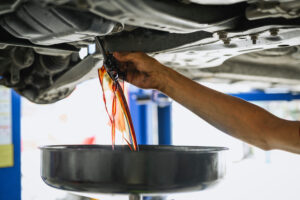
Since electric vehicles (EVs) don’t have a standard internal combustion engine (ICE), do they ever need an oil change? It’s a good question, as oil changes have been a regular part of preventative maintenance for most vehicle owners for over a century. Here’s the deal on oil changes for EVs.
It’s helpful to first understand why an ICE vehicle needs oil changes before learning why an EV is different. In an ICE vehicle, the engine burns fuel (typically gasoline or diesel) to produce power. This combustion process generates heat, which necessitates the use of oil to lubricate the engine and prevent excessive friction and wear. The oil also helps to dissipate that heat and remove impurities from the engine. Over time, the oil deteriorates and needs to be replaced, leading to the need for oil changes. While traditional guidelines would say change the oil every three months or three thousand miles, modern guidelines recommend about 7,500 to 15,000 miles with synthetic oil before needing a change.
Electric cars do not require traditional oil changes like ICE vehicles because EVs utilize electric motors instead of combustion engines, resulting in a fundamentally different powertrain design. Instead, they use batteries and electric motors to generate power and propel the vehicle. Since EVs rely on electric motors powered by batteries or fuel cells, these motors are much simpler in design compared to combustion engines. They contain fewer moving parts and do not generate the same amount of heat or friction as an internal combustion engine. Therefore, the need for oil to lubricate and cool the motor is eliminated.
Instead of oil changes, electric cars require regular maintenance on other components. One crucial aspect is the battery pack, which provides the energy to power the electric motor. Battery maintenance may involve periodic checks of its health and capacity, as well as ensuring proper cooling and temperature management. Battery performance can gradually decline over time, and in some cases, individual cells may need replacement. However, these maintenance activities are specific to the battery system and do not involve oil changes.
Additionally, other components in electric cars still require attention and maintenance. The braking system, suspension, tires, and electrical systems all need periodic inspections and service, just like in traditional vehicles. These are not related to oil changes but should be noted as they are part of the regularly scheduled maintenance needed to ensure optimal performance, efficiency and safety, just as an oil change does for ICE vehicles.
The absence of oil changes in electric cars contributes to environmental sustainability. Oil changes result in the production of used motor oil, which requires careful handling and disposal to prevent environmental contamination. By eliminating the need for oil changes, electric vehicles reduce the generation of used motor oil and minimize the associated environmental risks. Not having to change the oil can also save owners money, as many EV batteries need to be serviced between 12 to 15 years.
Electric cars do not require oil changes due to their different powertrain design and the absence of combustion engines. This is different for hybrids which use both electric and gas motors. Instead, the focus for EVs shifts to maintaining other components such as the battery, brakes, suspension, and electrical systems.
Electric vehicles offer the advantage of reduced maintenance needs, improved environmental sustainability, and lower operating costs associated with oil changes and related services. As technology continues to advance, electric vehicles are expected to become even more efficient and accessible, further solidifying their position as a viable and sustainable transportation option for the future.
Contact the any of our dealerships at Ontario Auto Center to learn more about available EVs and maintenance requirements.
While great effort is made to ensure the accuracy of the information on this site, errors can occur. Please verify all pricing information with a customer service representative. This is easily done by calling us or visiting us at the dealership.
Customer may not qualify for ALL Rebates shown. Some rebates are stackable and others can and cannot be combined. See Dealer For Complete Details.